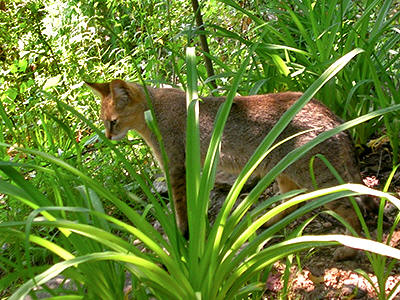 |
Order : CARNIVORA
Family : Felidae
Species : Felis chaus
Head-body length : 50-65 cm
Tail length : 26-31 cm
Weight : up to 6 kg
The Jungle Cat occurs in a
variety of open habitats including scrub forest, tall grassland and
cultivated areas, often near water bodies. It is mainly terrestrial in
habits, and is reportedly both nocturnal and diurnal. It is documented from
lowland areas to high elevations of up to 2400 metres in the Himalayas.
Its diet comprises a wide range of small animals such as lizards,
frogs, birds, large insects and particularly rodents.
This is a relatively small species of cat, with a small head and a
medium-sized tail. Its ears are long, pointed and tufted. Its fur colour is
variable, ranging from grey to pale brown and orange-brown. Its body fur
lacks spots or stripes, however there may be dark rings on the posterior
part of the tail.
The Jungle Cat ranges from parts of the Middle East (as far west as Egypt)
through parts of Central Asia and the Indian subcontinent (India, Nepal, Bangladesh) to southern
China. In Southeast Asia, where the species is increasingly rare, it is
known to occur in Myanmar, Thailand, Laos, Cambodia and Vietnam.
Populations in parts of Southeast Asia have declined severely due to hunting
and trapping.
Fig 1 : Example of the subspecies Felis chaus affinis (which inhabits
the Himalayan region), stalking amongst sun-dappled, long grass. Photo by
Shyamal L.
References :
Francis, C.M. 2019. A Field Guide to the Mammals of South-east Asia. Second
Edition. New Holland. 416 pp.
Gray, T.N.E., Timmins, R.J., Jathana, D., Duckworth, J.W., Baral, H. &
Mukherjee, S. 2021. Felis chaus (amended version of 2016 assessment). The
IUCN Red List of Threatened Species 2021: e.T8540A200639312. |